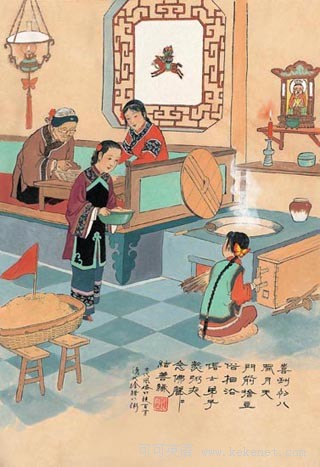
гҖҗиӢұж–ҮеҺҹж–ҮгҖ‘
Legend
Laba rice porridge was first introduced to China in the Song Dynasty about 900 years ago.
Buddhism was well accepted in the areas inhabited by the Han Chinese, who believed that Sakyamuni, the first Buddha and founder of the religion, attained enlightenment on the eighth day of the twelfth month. Sutras were chanted in the temples and rice porridge with beans, nuts and dried fruit was prepared for the Buddha. With the passing of time the custom extended, especially in rural areas where peasants would pray for a plentiful harvest in this way.
There is, however, another touching story: When Sakyamuni was on his way into the high mountains in his quest for understanding and enlightenment, he grew tired and hungry. Exhausted from days of walking, he fainted away by a river in India. A shepherdess found him there and fed him her lunch -- porridge made with beans and rice. Sakyamuni was thus able to continue his journey.
After six years of strict discipline, he finally realized his dream of full enlightenment on the eighth day of the twelfth lunar month. Ever since, monks have prepared rice porridge on the eve and held a ceremony the following day, during which they chant sutras and offer porridge to Buddha. Thus, the tradition of eating Laba porridge was based in religion, though with the passing of time the food itself became a popular winter dish especially in cold northern China.
According to written records, large Buddhist temples would offer Laba rice porridge to the poor to show their faith to Buddha. In the Ming Dynasty about 500 years ago, it became such a holy food that emperors would offer it to their officials during festivals. As it gained favor in the feudal upper class, it also quickly became popular throughout the country.
гҖҗдёӯж–ҮиҜ‘ж–ҮгҖ‘
дј иҜҙ
и…Ҡе…«зІҘеңЁеӨ§зәҰ900е№ҙеүҚзҡ„е®Ӣд»ЈйҰ–ж¬Ўеј•е…ҘдёӯеӣҪгҖӮ
еңЁжұүж—Ҹдәәеұ…дҪҸзҡ„ең°еҢәпјҢдҪӣж•ҷиў«е№ҝжіӣең°жҺҘеҸ—пјҢдәә们зӣёдҝЎз¬¬дёҖдёӘдҪӣе’ҢдҪӣж•ҷзҡ„еҲӣе§ӢдәәйҮҠиҝҰзүҹе°јеңЁз¬¬еҚҒдәҢдёӘжңҲзҡ„第八еӨ©еҫ—еҲ°дәҶеҗҜеҸ‘гҖӮдҪӣз»ҸеңЁеҜәеәҷдәҶиў«еҗҹиҜөпјҢеҗ«иұҶгҖҒеқҡжһңе’Ңе№Іжһңзҡ„зІҘз”ЁжқҘдҫӣеҘүдҪӣдё»гҖӮйҡҸзқҖж—¶й—ҙзҡ„жҺЁз§»пјҢиҝҷдёӘйЈҺдҝ—жү©еұ•ејҖдәҶпјҢе°Өе…¶жҳҜеңЁд№Ўжқ‘ең°еҢәпјҢеҶң民们д»Ҙиҝҷз§Қж–№ејҸзҘҲзҘ·еҘҪзҡ„收жҲҗгҖӮ
然иҖҢпјҢиҝҳжңүдёҖдёӘеҠЁдәәзҡ„ж•…дәӢпјҡеҪ“йҮҠиҝҰзүҹе°јеңЁйҖҡеҗ‘д»–еҜ»жұӮйўҶжӮҹе’ҢеҗҜеҸ‘зҡ„й«ҳеұұзҡ„и·ҜдёҠпјҢд»–еҸҲзҙҜеҸҲйҘҝгҖӮз”ұдәҺеҮ еӨ©зҡ„иЎҢиө°иҖҢдә§з”ҹзҡ„з–Іжғ«пјҢд»–еңЁеҚ°еәҰзҡ„дёҖжқЎжІіиҫ№жҷ•еҖ’гҖӮдёҖдёӘзү§зҫҠеҘіеҸ‘зҺ°дәҶеҘ№е№¶е–Ӯд»–еҚҲйҘӯпјҢйҘӯжҳҜз”ұиұҶе’ҢзұіеҒҡжҲҗзҡ„зІҘгҖӮдәҺжҳҜпјҢйҮҠиҝҰзүҹе°јиғҪеӨҹ继з»ӯд»–зҡ„ж—…зЁӢгҖӮ
з»ҸиҝҮе…ӯе№ҙдёҘж јзҡ„дҝ®иЎҢпјҢд»–жңҖз»ҲдәҺеҚҒдәҢжңҲзҡ„第八еӨ©е®һзҺ°дәҶд»–е®Ңе…ЁеҗҜеҸ‘зҡ„жўҰжғігҖӮд»ҺйӮЈж—¶еҲ°зҺ°еңЁпјҢеғ§дҫЈд»¬еңЁеүҚж—ҘеҮҶеӨҮзұізІҘпјҢеңЁз¬¬дәҢеӨ©дёҫиЎҢд»ӘејҸпјҢеңЁжӯӨжңҹй—ҙпјҢ他们еҗҹиҜөдҪӣз»ҸпјҢ并дёәдҪӣзҘ–дҫӣеҘүзұізІҘгҖӮеӣ иҖҢпјҢеҗғи…Ҡе…«зІҘзҡ„дј з»ҹжҳҜд»Ҙе®—ж•ҷеҹәдәҺе®—ж•ҷзҡ„пјҢеҸҜжҳҜпјҢйҡҸзқҖж—¶й—ҙзҡ„жҺЁз§»пјҢиҝҷз§ҚйЈҹзү©жң¬иә«е°Өе…¶жҳҜеңЁеҜ’еҶ·зҡ„еҢ—ж–№жҲҗдёәеҸ—ж¬ўиҝҺзҡ„еҶ¬еӯЈйЈҹзү©гҖӮ
ж №жҚ®ж–Үеӯ—и®°еҪ•пјҢеӨ§зҡ„дҪӣж•ҷеҜәеәҷдјҡдёәз©·дәәжҸҗдҫӣи…Ҡе…«зІҘпјҢд»ҘиЎЁиҫҫ他们еҜ№дҪӣзҘ–зҡ„иҷ”иҜҡгҖӮеңЁеӨ§зәҰ500е№ҙеүҚзҡ„жҳҺд»ЈпјҢи…Ҡе…«зІҘжҲҗдёәеҰӮжӯӨзҘһеңЈзҡ„йЈҹе“ҒпјҢд»ҘиҮізҡҮеёқеңЁиҠӮж—Ҙжңҹй—ҙеҗ‘д»–зҡ„е®ҳе‘ҳ们жҸҗдҫӣгҖӮз”ұдәҺи…Ҡе…«зІҘеңЁе°Ғе»әзӨҫдјҡзҡ„дёҠеұӮйҳ¶зә§дёӯеҫ—е® пјҢе®ғд№ҹеҫҲеҝ«еңЁе…ЁеӣҪжөҒиЎҢгҖӮ














